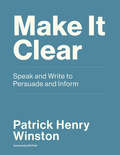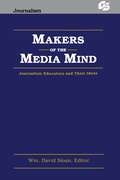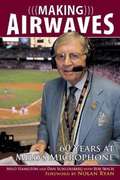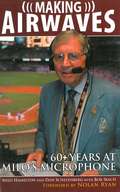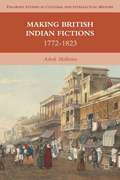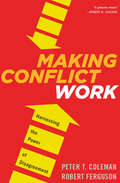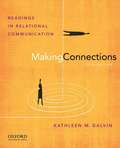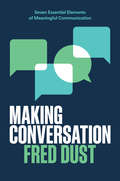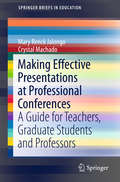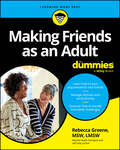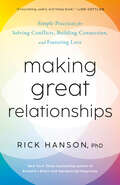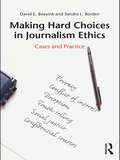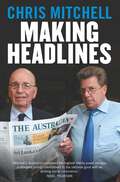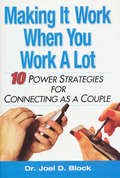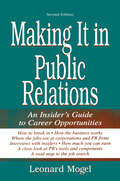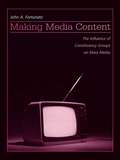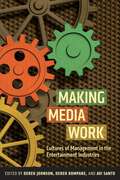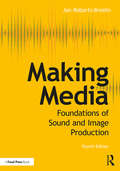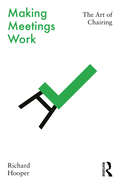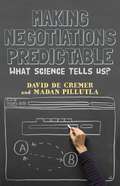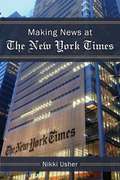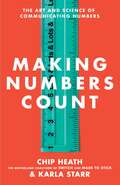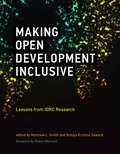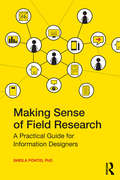- Table View
- List View
Make it Clear: Speak and Write to Persuade and Inform
by Patrick Henry WinstonThe essentials of communication for professionals, educators, students, and entrepreneurs, from organizing your thoughts to inspiring your audience and ensuring what you say is remembered.Do you give presentations at meetings? Do you ever have to explain a complicated subject to audiences unfamiliar with your field? Do you make pitches for ideas or products? Do you want to interest a lecture hall of restless students in subjects that you find fascinating? Then you need this book. Make It Clear explains how to communicate--how to speak and write to get your ideas across. Written by an MIT professor who taught his students these techniques for more than forty years, the book starts with the basics--finding your voice, organizing your ideas, making sure what you say is remembered, and receiving critiques ("do not ask for brutal honesty")--and goes on to cover such specifics as preparing slides, writing and rewriting, and even choosing a type family.
Makers of the Media Mind: Journalism Educators and their Ideas (Routledge Communication Series)
by Wm. David SloanMakers of the Media Mind is a collection of analytical essays focusing on the most important and original ideas contributed to the field of mass communication by journalism educators. Divided into six sections representing the most prominent areas of specialization in the field, this text serves two significant purposes: first, it acquaints readers with the lives of preeminent journalism educators; second, it provides concise discussions and evaluations of the most compelling ideas those educators have to offer. The editor of, and contributors to, this text contend that ideas cannot be appreciated fully without an understanding of the creators of those same ideas. They hope that this volume's coverage of "creators" as well as concepts will demonstrate that journalism education has played a critical role in the making of the "media mind."
Making Airwaves: 60 Years at Milo's Microphone
by Milo Hamilton Dan Schlossberg Bob IbachSportscaster, Milo Hamilton, discusses his 60-year as a sports announcer, concentrating on baseball. He discusses the teams and people with whom he worked.
Making Airwaves: 60+ Years at Milo's Microphone
by Milo HamiltonMissingMilo Hamilton has called 11 no-hitters and a World Series, often in tandem with such broadcast legends as Jack Buck, Jack Brickhouse, Bob Elson, and Harry Caray. His work was so well-received that he was enshrined into the broadcasters? wing of the Baseball Hall of Fame in 1992. He received an even more unexpected honor eight years later ? election to the exclusive Radio Hall of Fame, of which only seven other baseball broadcasters belong. He has truly managed to work his way up from humble origins. The story he tells in Making Airwaves: 60 Years at Milo's Microphone is a profile in courage, a tale of talent and determination, and a behind-the-scenes look at seven decades of baseball history.
Making British Indian Fictions
by Ashok MalhotraThis book examines fictional representations of India in novels, plays and poetry produced between the years 1772 to 1823 as historical source material. It uses literary texts as case studies to investigate how Britons residing both in the metropole and in India justified, confronted and imagined the colonial encounter during this period. The study will situate the texts in relation to the shifting colonial context and to the changing attitudes towards India within Britain in general and on the part of Britons who had experience of living in India, such as East India Company men or their wives and daughters, in particular. Moreover, it will analyse how this literature responded to the increasing influence of the subcontinent on metropolitan culture. This book, then, approaches fictional texts as case studies that illuminate trends taking place within Britain such as the growing consumption of Indian-style imported goods and the commoditisation of an Indian aesthetic within British visual culture. Whilst the book will utilise fictional portrayals to comment upon shifts in the relationship between coloniser and colonised and to discuss the cross-cultural influences between the metropole and the colonial periphery, it also outlines how literary production and print capitalism played a part in shaping depictions of the subcontinent and stereotypes of the colonial 'other'. The study will also examine how representations of the subcontinent in British art and scholarship were influenced by metropolitan literary and popular culture. At the same time it will look at how representations by metropolitan authors influenced early-nineteenth century depictions by British authors who resided in India.
Making Conflict Work: Harnessing the Power of Disagreement
by Peter T. Coleman Robert FergusonA provocative guide to navigating conflict in the workplace by assessing power dynamics and adapting your tactics accordingly.
Making Connections: Readings in Relational Communication
by Kathleen GalvinMaking Connections: Readings in Relational Communication, Fifth Edition, is a unique collection of readings that provides a balanced, timely, and challenging set of perspectives on relational communication. Edited by Kathleen M. Galvin, the volume includes diverse selections from the recent work of top communication scholars and teachers, offering a balance between humanistic and social-science perspectives. Each reading exposes students to the latest developments in the ever-changing field of interpersonal communication.
Making Conversation: Seven Essential Elements of Meaningful Communication
by Fred DustA former Senior Partner and Global Managing Director at the legendary design firm IDEO shows how to design conversations and meetings that are creative and impactful. Conversations are one of the most fundamental means of communicating we have as humans. At their best, conversations are unconstrained, authentic and open—two or more people sharing thoughts and ideas in a way that bridges our individual experiences, achieves a common goal. At their worst, they foster misunderstanding, frustration and obscure our real intentions.How often do you walk away from a conversation feeling really heard? That it moved the people in it forward in some important way? You’re not alone. In his practice as a designer, Fred Dust began to approach conversations differently. After years of trying to broker communication between colleagues and clients, he came to believe there had to a way to design the art of conversation itself with intention and purpose, but still artful and playful. Making Conversation codifies what he learned and outlines the seven elements essential to successful exchanges: Commitment, Creative Listening, Clarity, Context, Constraints, Change, and Create. Taken together, these seven elements form a set of resources anyone can use to be more deliberate and purposeful in making conversations work.
Making Effective Presentations at Professional Conferences
by Mary Renck Jalongo Crystal MachadoThis work prepares teachers, college students, and higher education faculty to conduct various types of presentations, including workshops and teacher inservice trainings; poster sessions; panel discussions; roundtables; research forums; and technology-supported presentations. Making effective presentations to fellow professionals at conferences is an important contribution for educators at all levels, from basic through higher education. The book takes the approach of a "paper mentor" that guides the reader through the use of templates, specific examples, and a wide range of on-line resources.
Making Friends as an Adult For Dummies
by Rebecca GreeneMake lasting friendships at any age Making Friends as an Adult For Dummies helps you overcome the challenges of building friendships, forming new bonds, and meeting new people. First, you'll learn what your friendship needs are and decide what kind of friends you'd like to meet. Then you'll get concrete advice for building a new social circle, turning acquaintances into good friends, and letting go of friendships that just aren't working out. Single or married, parent or childfree, many people face these same challenges. This Dummies guide will show you that you aren't alone and will help you discover sustainable ways to overcome loneliness, keep friendships going despite occasional tension, and build your “family of choice.” Assess your friendship needs and learn how to find people who would make good friends Gain the communication skills to resolve conflict in new and existing platonic relationships Overcome your fear of rejection and learn to politely end friendships that aren't working Learn to be a good friend and deepen the friendships you build Make friends after retirement, relocation, extended isolation—or just because friends are nice to have. Making Friends as an Adult For Dummies is the judgment-free book that makes it easy.
Making Great Relationships: Simple Practices for Solving Conflicts, Building Connection, and Fostering Love
by Rick Hanson&“50 simple, powerful ways to improve your relationships at home and at work&” (Lori Gottlieb, author of Maybe You Should Talk To Someone), based on the latest findings in neuroscience, mindfulness, and positive psychology—by the New York Times bestselling author of Neurodharma and ResilientRelationships are usually the most important part of a person&’s life. But they&’re often stressful and frustrating, or simply awkward, distant, and lonely. We feel the weight of things unsaid, needs unmet, conflicts unresolved. It&’s easy to feel stuck. But actually, new research shows that you create your relationships every day with the things you do and say, which gives you the ability to start improving them now. You have the power to make all your relationships better just by making simple changes that start inside yourself. New York Times bestselling author of Buddha&’s Brain and Hardwiring Happiness, Rick Hanson, PhD, brings his trademark warmth and clarity to Making Great Relationships, a comprehensive guide to fostering healthy, effective, and fulfilling relationships of all kinds: at home and at work, with family and friends, and with people who are challenging. As a psychologist, couples and family counselor, husband, and father, Dr. Hanson has learned what makes relationships go badly and what you can do to make them go better. Grounded in brain science and clinical psychology, and informed by contemplative wisdom, Making Great Relationships offers fifty fundamental skills, including: • How to convince yourself that you truly deserve to be treated well• How to communicate effectively in all kinds of settings• How to stay centered so that conflict doesn&’t rattle you so deeply• How to see the good in others (even when they make it difficult)• How to set and maintain healthy boundaries or resize relationships as needed• How to express your needs so that they are more likely to be fulfilled With these fifty simple yet powerful practices, you can handle conflicts, repair misunderstandings, get treated better, deepen a romantic partnership, be at peace with others, and give the love that you have in your heart. Making Great Relationships will teach you how to relate better than ever with all the people in your life.
Making Hard Choices in Journalism Ethics: Cases and Practice
by David E. Boeyink Sandra L. BordenThis book teaches students how to make the difficult ethical decisions that journalists routinely face. By taking a case-based approach, the authors argue that the best way to make an ethical decision is to look closely at a particular situation, rather than looking first to an abstract set of ethical theories or principles. This book goes beyond the traditional approaches of many other journalism textbooks by using cases as the starting point for building ethical practices. Casuistry, the technical name of such a method, develops provisional guidelines from the bottom up by reasoning analogically from an "easy" ethical case (the "paradigm") to "harder" ethical cases. Thoroughly grounded in actual experience, this method admits more nuanced judgments than most theoretical approaches.
Making Headlines
by Chris MitchellAs editor-in-chief of The Australian, Chris Mitchell ran the largest stable of journalists with the largest editorial budget in the country for more than twelve years. This entertaining and deeply revealing book offers readers riveting insights into the quirks and foibles of some of the most powerful politicians and media executives this country has produced. A controversial figure throughout his quarter of a century as a daily editor, Chris Mitchell still maintains close regular contact with past prime ministers, editors and media CEOs. Making Headlines highlights the judgements and thinking that govern daily newspaper journalism at the highest level and the battles fought to publish tough stories about the rich and the powerful, the disenfranchised and the powerless. Making Headlines is compulsory reading for citizens who care, the political class inside the beltway and beyond, and wannabe journalists in search of a job.
Making It Work When You Work A Lot: 10 Power Strategies For Connecting As A Couple
by Joel D. BlockA sampling of real-life stories behind the curtain in the executive suite: Marion has a ten-percent marriage. Her husband is on the road eighty percent of the time and catches up on sleep half of the time he is at home. She uses innovative techniques to save her relationship. The neglect and resentment Joyce felt as a result of her husband Paul's extraordinary work schedule was temporarily eased by her fling with a former colleague. She confessed her infidelity to Paul--and they're still together! Learn about repair strategies that are tried and proven. Rob, a stay-at-home dad, also considered having an affair. He's come up with a better solution, one that saved his marriage as well as his ego. Kevin had developed an intriguing method for keeping Janice at a distance. We'll see how Janice reacted and what they did to bring value back to their relationship. Alex badgered Florence about her housekeeping, then acknowledged that his beef was Florence's meteoric career progression, especially since his career had stalled. Unlike many other couples where the wife is the bigger earner, Florence and Alex worked things out brilliantly. These successful couples have confronted--and overcome--the considerable challenges of balancing work and home life by focusing on the bottom line: strategies for maintaining the vitality, energy, and love that first brought them together. In this groundbreaking guide, relationship specialist Dr. Joel Block will show you what they did, how they did it, and how you can, too. Let this book be your portable relationship coach--the ultimate resource for Making It Work When You Work a Lot. Dr. Joel Block is a clinical psychologist specializing in couples therapy. His success in treating hundreds of devastated executive marriages over the years has led him to formulate a blueprint for success that addresses the challenges that are unique to these relationships. Making It Work When You Work a Lot is a real-life action plan with the mission of protecting executive marriages. It was formulated after interviews with nearly one hundred executives and their spouses, men and women from across the country. Each chapter is derived from the specific concerns of executives struggling to make their marriages work. As you will discover, the issues they raised involve competencies that are also crucial in the world of business. Dr. Block shows you how solutions to problems encountered in the workplace translate directly to successful resolutions of similar challenges at home: 1.
Making It in Public Relations: An Insider's Guide To Career Opportunities
by Leonard MogelMaking It in Public Relations is a comprehensive, realistic guide to everything one needs to know when pursuing a successful career in public relations. It is an introduction to public relations, written for students who want or need a definition of the profession to understand what they are moving into as a career. A thorough overview of the various roles and responsibilities involved in PR work, the different types of PR functions and activities, and its application in a variety of settings and scenarios are provided. In fulfilling the book's editorial role, author Leonard Mogel profiles the 10 largest public relations firms, life on the fast track at a small PR firm, how corporate communications is carried on at a large financial institution, and public relations for diverse organizations. It will be of interest to those studying public relations at the university level; recent mass communication, journalism, and public relations graduates; interns in public relations firms; and employees in other fields contemplating a move to this profession.
Making Media Content: The Influence of Constituency Groups on Mass Media (Routledge Communication Series)
by John A. FortunatoMaking Media Content addresses the development of media content and the various factors and constituencies that influence content, such as advertisers, corporate interests, owners, and advocacy groups. It examines the strategic decision-making of mass media organizations as they determine what content they present to their audiences through broadcast, publication, or electronic access. The work focuses on the internal and external influences on media content, laying out the various processes and opening up the topic for further consideration.This book will appeal to academics in mass media, especially those studying the relationship between mass media organizations and public relations, and advertisers. Practitioners of the media, public relations, and advertising fields would be interested because there are practical applications to their industries and explanations of the communication interactions between these groups.
Making Media Work: Cultures of Management in the Entertainment Industries (Critical Cultural Communication #17)
by Derek JohnsonThe management and labor culture of the entertainment industry. In popular culture, management in the media industry isfrequently understood as the work of network executives, studio developers, andmarket researchers—“the suits”—who oppose the more productive forces ofcreative talent and subject that labor to the inefficiencies and risk aversionof bureaucratic hierarchies. However, such portrayals belie the realityof how media management operates as a culture of shifting discourses,dispositions, and tactics that create meaning, generate value, and shape mediawork throughout each moment of production and consumption.Making Media Work aims to provide a deeper and more nuanced understanding ofmanagement within the entertainment industries. Drawing from work in criticalsociology and cultural studies, the collection theorizes management as apervasive, yet flexible set of principlesdrawn upon by a wide range ofpractitioners—artists, talent scouts, performers, directors, show runners, andmore—in their ongoing efforts to articulate relationships and bridgepotentially discordant forces within the media industries. The contributorsinterrogate managerial labor and identity, shine a light on how managementunderstands its roles within cultural and creative contexts, and reconfigurethe complex relationship between labor and managerial authority as productiverather than solely prohibitive. Engaging with primary evidence gathered throughinterviews, archives, and trade materials, the essays offer tremendous insightinto how management is understood and performed within media industry contexts.The volume as a whole traces the changing roles of management both historicallyand in the contemporary moment within US and international contexts, and acrossa range of media forms, from film and television to video games and socialmedia.
Making Media: Foundations of Sound and Image Production (Making Media: Foundations Of Sound And Image Production Ser.)
by Jan Roberts-BreslinMaking Media: Foundations of Sound and Image Production takes the media production process and deconstructs it into its most basic components. Students will learn the basic concepts of media production – frame, sound, light, time, motion, and sequencing – and be able to apply them to any medium they choose, from film and television to fine art and online applications. They will also become well-grounded in the digital work environment and the tools required to produce media in today’s digital environment. This new fourth edition is completely updated and includes a new chapter on the production process and production safety; information on current trends in production, exhibition, and distribution; and much more. New topics include virtual and augmented reality, the use of drones and new practices interactive media. The text is also fully illustrated and includes sidebar discussions of pertinent issues throughout. The companion website has been completely revamped with interactive exercises for each chapter, allowing students to explore the process of media production.
Making Meetings Work: The Art of Chairing
by Richard HooperMaking Meetings Work is a short book which aims to help people chair meetings better – meetings of all kinds from community playgroups to conferences and dinners to large corporate Boards. The book is based on the personal experience of a professional working chair over many years. The book is aimed at younger men and women who are beginning to chair their first meetings, and also at more experienced chairs who want to develop their skills.
Making National News
by Gene AllenFor almost a century, Canadian newspapers, radio and television stations, and now internet news sites have depended on the Canadian Press news agency for most of their Canadian (and, through its international alliances) foreign news. This book provides the first-ever scholarly history of CP, as well as the most wide-ranging historical treatment of twentieth-century Canadian journalism published to date.Using extensive archival research, including complete and unfettered access to CP's archives, Gene Allen traces how CP was established and evolved in the face of frequent conflicts among the powerful newspaper publishers - John Ross Robertson, Joseph Atkinson, and Roy Thomson, among others - who collectively owned it, and how the journalists who ran it understood and carried out their work. Other major themes include CP's shifting relationships with the Associated Press and Reuters; its responses to new media; its aggressive shaping of its own national role during the Second World War; and its efforts to meet the demands of French-language publishers.Making National News makes a substantial and original contribution to our understanding of journalism as a phenomenon that shaped Canada both culturally and politically in the twentieth century.
Making Negotiations Predictable
by David De Cremer Madan M. PillutlaNegotiation is an everyday activity that everyone, knowingly or unknowingly, engages in. The impact of negotiating can be very significant for revenues and profitability of organizations and individuals. It is also an important determinant of the sustainability of any kind of relationship. Therefore it is important to be an effective negotiator and everybody has the potential to be one. This book will provide crucial insights into how you can become a great negotiator, by discussing the science and psychology of negotiation techniques. It is a given that many of our negotiations do not always turn out the way we expect. Although for many of us, negotiations are best approached by employing rational procedures, real life shows us the need to understand seemingly irrational behaviours that result in suboptimal outcomes. Most negotiators remain blind to what really motivates them and the other parties in the negotiation. Why? We discuss the biases that prevent us from achieving this understanding. By understanding the psychology of negotiators and the negotiation process, we can make negotiations more predictable and profitable.
Making News At The New York Times
by Nikki UsherMaking News at The New York Times is the first in-depth portrait of the nation's, if not the world's, premier newspaper in the digital age. It presents a lively chronicle of months spent in the newsroom observing daily conversations, meetings, and journalists at work. We see Page One meetings, articles developed for online and print from start to finish, the creation of ambitious multimedia projects, and the ethical dilemmas posed by social media in the newsroom. Here, the reality of creating news in a 24/7 instant information environment clashes with the storied history of print journalism, and the tensions present a dramatic portrait of news in the online world. This news ethnography brings to bear the overarching value clashes at play in a digital news world. The book argues that emergent news values are reordering the fundamental processes of news production. Immediacy, interactivity, and participation now play a role unlike any time before, creating clashes between old and new. These values emerge from the social practices, pressures, and norms at play inside the newsroom as journalists attempt to negotiate the new demands of their work. Immediacy forces journalists to work in a constant deadline environment, an ASAP world, but one where the vaunted traditions of yesterday's news still appear in the next day's print paper. Interactivity, inspired by the new user-computer directed capacities online and the immersive Web environment, brings new kinds of specialists into the newsroom, but exacts new demands upon the already taxed workflow of traditional journalists. And at time where social media presents the opportunity for new kinds of engagement between the audience and media, business executives hope for branding opportunities while journalists fail to truly interact with their readers.
Making Numbers Count: The Art and Science of Communicating Numbers
by Chip Heath Karla StarrA clear, practical, first-of-its-kind guide to communicating and understanding numbers and data—from bestselling business author Chip Heath.How much bigger is a billion than a million? Well, a million seconds is twelve days. A billion seconds is…thirty-two years. Understanding numbers is essential—but humans aren&’t built to understand them. Until very recently, most languages had no words for numbers greater than five—anything from six to infinity was known as &“lots.&” While the numbers in our world have gotten increasingly complex, our brains are stuck in the past. How can we translate millions and billions and milliseconds and nanometers into things we can comprehend and use? Author Chip Heath has excelled at teaching others about making ideas stick and here, in Making Numbers Count, he outlines specific principles that reveal how to translate a number into our brain&’s language. This book is filled with examples of extreme number makeovers, vivid before-and-after examples that take a dry number and present it in a way that people click in and say &“Wow, now I get it!&” You will learn principles such as: -SIMPLE PERSPECTIVE CUES: researchers at Microsoft found that adding one simple comparison sentence doubled how accurately users estimated statistics like population and area of countries. -VIVIDNESS: get perspective on the size of a nucleus by imagining a bee in a cathedral, or a pea in a racetrack, which are easier to envision than &“1/100,000th of the size of an atom.&” -CONVERT TO A PROCESS: capitalize on our intuitive sense of time (5 gigabytes of music storage turns into &“2 months of commutes, without repeating a song&”). -EMOTIONAL MEASURING STICKS: frame the number in a way that people already care about (&“that medical protocol would save twice as many women as curing breast cancer&”). Whether you&’re interested in global problems like climate change, running a tech firm or a farm, or just explaining how many Cokes you&’d have to drink if you burned calories like a hummingbird, this book will help math-lovers and math-haters alike translate the numbers that animate our world—allowing us to bring more data, more naturally, into decisions in our schools, our workplaces, and our society.
Making Open Development Inclusive: Lessons from IDRC Research (International Development Research Centre)
by Matthew L. Smith and Ruhiya Kristine SewardDrawing on ten years of empirical work and research, analyses of how open development has played out in practice.A decade ago, a significant trend toward openness emerged in international development. "Open development" can describe initiatives as disparate as open government, open health data, open science, open education, and open innovation. The theory was that open systems related to data, science, and innovation would enable more inclusive processes of human development. This volume, drawing on ten years of empirical work and research, analyzes how open development has played out in practice.
Making Sense of Field Research: A Practical Guide for Information Designers
by Sheila PontisLearn how to use field research to bring essential people-centred insights to your information design projects. Information design is recognized as the practice of making complex data and information understandable for a particular audience, but what’s often overlooked is the importance of understanding the audience themselves during the information design process. Rather than rely on intuition or assumptions, information designers need evidence gathered from real people about how they think, feel, and behave in order to inform the design of effective solutions. To do this, they need field research. If you’re unsure about field research and how it might fit into a project, this book is for you. This text presents practical, easy-to-follow instructions for planning, designing, and conducting a field study, as well as guidance for making sense of field data and translating findings into action. The selection of established methods and techniques, drawn from social sciences, anthropology, and participatory design, is geared specifically toward information design problems. Over 80 illustrations and five real-world case studies bring key principles and methods of field research to life. Whether you are designing a family of icons or a large-scale signage system, an instruction manual or an interactive data visualization, this book will guide you through the necessary steps to ensure you are meeting people’s needs.
